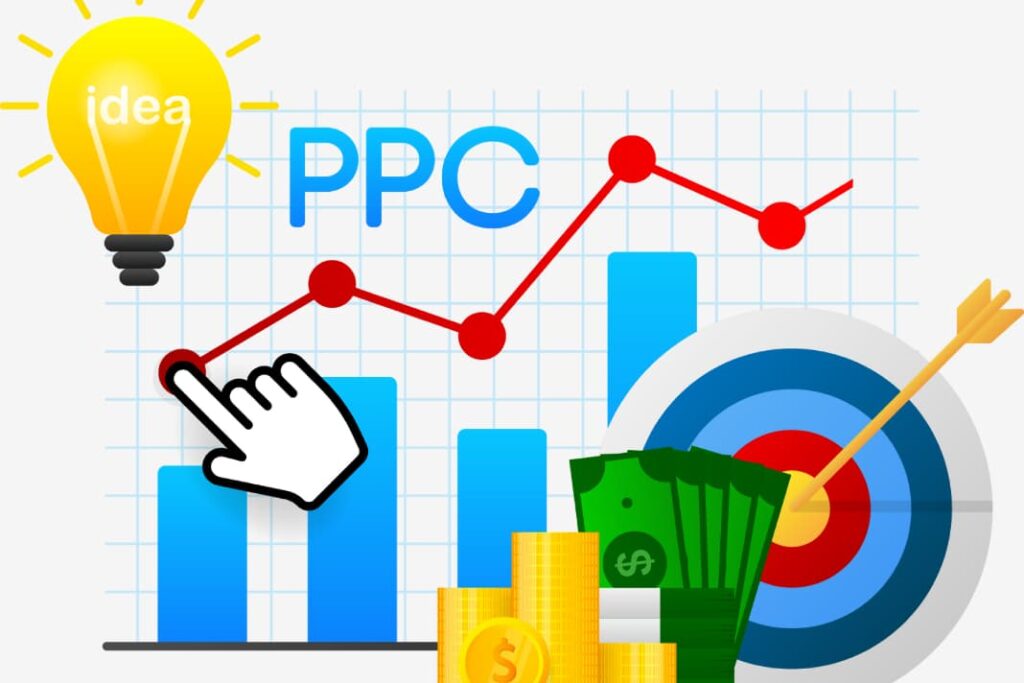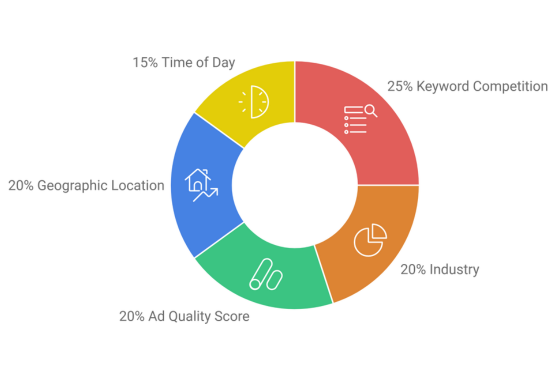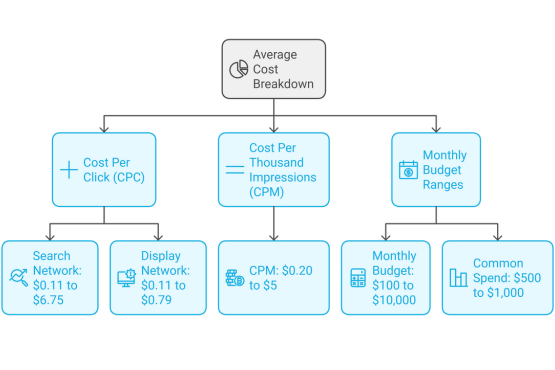Google Ads dominates digital advertising, with over 83% of the global search engine market share. For businesses aiming to boost their online visibility, understanding Google Ads pricing is crucial. This guide breaks down the costs, strategies, and potential returns of Google Ads campaigns in 2024.
Key Takeaways:
- Google Ads costs vary widely, with businesses spending $100 to $10,000+ monthly.
- Average cost-per-click (CPC) ranges from $0.11 to $6.75, depending on the industry.
- Factors influencing costs include keyword competition, industry, and ad networks.
- Optimization strategies can significantly reduce costs and improve ROI
- Google Ads can deliver an average return of $8 for every $1 spent
Google Ads is a powerhouse for businesses looking to boost their online presence. But a common question lingers: “What’s the price tag?” Let’s dive into pay-per-click advertising costs and uncover the true value of Google Ads in 2024.
Understanding Google Ads Pricing
Google Ads operates on a complex pricing model that can seem daunting at first glance. However, grasping the basics is crucial for crafting a cost-effective advertising strategy.
The Auction System: How It Works
Google Ads uses an auction system where advertisers bid on keywords. When a user searches for a term, Google runs an auction to determine which ads appear and in what order. But it’s not just about who bids the highest – ad quality and relevance play significant roles, too.
Factors Influencing Your Ad Spend
Several elements impact how much you’ll shell out for Google Ads:
- Keyword Competition: High-demand keywords cost more.
- Industry: Some sectors, like legal and finance, have higher average CPCs.
- Ad Quality Score: Better ads can lower your costs.
- Geographic Location: Advertising in competitive markets increases prices.
- Time of Day: Peak hours might cost more but offer better conversion rates.
How does Google Ads determine your CPC?
Google Ads determines your CPC through a combination of factors in its auction system:
- Maximum Bid: The highest amount you’re willing to pay per click.
- Quality Score: A rating based on:
- Ad relevance
- Expected click-through rate (CTR)
- Landing page experience
- Ad Rank: Calculated using:
- Your bid
- Quality Score
- Expected impact of ad extensions
- Actual CPC: The minimum amount needed to maintain your ad position above the next competitor is often lower than your maximum bid.
- Competition: The number and quality of other advertisers bidding on the exact keywords affect your CPC.
Remember, improving your Quality Score can help lower your CPC while maintaining or improving your ad position.
Breaking Down the Costs
Let’s look at the numbers to give you a clearer picture of Google Ads pricing in 2024.
Average Cost-Per-Click (CPC)
CPC varies significantly across industries:
| Industry | Average CPC (Search Network) | Average CPC (Display Network) |
|---|---|---|
| Advocacy | $1.43 | $0.62 |
| B2B | $3.33 | $0.79 |
| Legal | $6.75 | $0.72 |
These figures highlight the importance of understanding your industry’s benchmarks when budgeting for PPC advertising.
Monthly Ad Spend
Most businesses allocate between $500 and $1,000 monthly for Google Ads. However, this range can extend from $100 for small local businesses to over $10,000 for large corporations or highly competitive industries.
Cost Per Lead (CPL)
For Google Local Services ads, expect to pay between $6 and $30 per lead. This metric is crucial for calculating your return on investment (ROI) and determining the effectiveness of your digital marketing budget.
Optimizing Your Ad Spend
Knowing the costs is just the beginning. To make the most of your online advertising budget, consider these strategies:
- Refine Your Keyword Strategy: Focus on long-tail, less competitive keywords but more specific to your offerings.
- Improve Quality Score: Create relevant, high-quality ads and landing pages to boost your score and lower costs.
- Use Ad Extensions: These free additions can improve your ad’s visibility and click-through rate without increasing costs.
- Set Smart Bidding Strategies: Leverage Google’s AI-powered bidding options to optimize your goals.
- Regularly Perform Competitive Keyword Analysis: Stay ahead by understanding what your competitors are bidding on and adjusting your strategy accordingly.
Measuring Success: Beyond the Cost
While understanding PPC advertising costs is crucial, it’s equally important to measure the success of your campaigns. Key performance metrics include:
- Click-Through Rate (CTR): The average CTR for Google Ads is between 4% and 6%.
- Conversion Rate: Expect an average of 3% to 6% for well-optimized campaigns.
- Return on Ad Spend (ROAS): Google Ads can deliver an impressive average ROI of 800%.
These metrics help you gauge the effectiveness of your ad spend and refine your strategies for better results.
Factors Influencing Costs
Keyword Competition
The demand for specific keywords significantly impacts Google Ads costs. Here’s what you need to know:
- High-competition keywords in industries like legal and finance often cost more
- Long-tail keywords typically have lower CPCs and can offer better ROI
Ads Network
Google offers two main advertising networks:
- Search Network: Text ads appearing in search results
- Display Network: Visual ads shown on websites, reaching over 90% of internet users
Each network has its pricing structure, affecting overall costs.
Average Cost Breakdown
Cost Per Click (CPC)
The average CPC for Google Ads ranges from $0.11 to $6.75, depending on the industry and network:
- Search Network: $0.11 to $6.75
- Display Network: $0.11 to $0.79
Cost Per Thousand Impressions (CPM)
For display ads, advertisers often use CPM pricing. Rates vary but typically fall between $0.20 and $5 per 1000 impressions.
Monthly Budget Ranges
Businesses typically allocate between $100 and $10,000 monthly for Google Ads, with many spending $500 to $1,000 monthly.
Strategies to Optimize Costs
Bidding Strategies
Choose the right bidding strategy to manage costs while achieving campaign goals:
- Manual CPC: Set bids yourself
- Automated bidding: Let Google optimize bids based on your goals
- Enhanced CPC: Automatically adjust manual bids
Quality Score Importance
A higher Quality Score can lead to better ad positions at lower costs. Focus on:
- Ad relevance
- Expected click-through rate (CTR)
- Landing page experience
Ad Relevance and Extensions
Create relevant ads and use extensions to improve CTR without increasing costs. Consider:
- Sitelink extensions
- Callout extensions
- Structured snippet extensions
Advanced Optimization Techniques
- A/B Testing: Continuously test ad copy and landing pages to improve performance
- Remarketing: Target users who have previously interacted with your website
- Audience Targeting: Utilize demographic and interest-based targeting for more precise ad delivery
Budgeting for Google Ads
Setting a Realistic Budget
Consider these factors when budgeting:
- Industry benchmarks
- Business goals
- Competition level
- Available resources
Minimum Spend Recommendations
While there’s no official minimum, experts often suggest:
- Daily budget: $10 – $50
- Monthly budget: $300 – $1,500
These figures allow for meaningful data collection and campaign optimization.
Monitoring and Adjusting Budgets
Regular budget reviews based on performance data are essential. Key metrics to track include:
- Click-through rate (CTR): Average 4% – 6%
- Conversion rate: Typical range of 3% – 6%
- Return on ad spend (ROAS)
Future Trends in Google Ads
Stay ahead of the curve by preparing for these emerging trends:
- Increased emphasis on AI-driven optimization
- Growth in visual and video ad formats
- Greater integration of first-party data for targeting
Conclusion: Is Google Ads Worth It?
Google Ads can deliver an impressive average return of $8 for every $1 spent, making it a potentially lucrative investment. Success requires careful planning, ongoing optimization, and a commitment to learning.
Now is the time to evaluate your current advertising strategies. Are you making the most of your digital ad spend? Consider consulting with a Google Ads expert to unlock the full potential of your campaigns.
By leveraging the strategies outlined in this guide, you can navigate the complex world of Google Ads pricing and turn your ad spend into a powerful engine for business growth in 2024 and beyond.
Frequently Asked Questions
How can I lower my CPC?
Improve Quality Score by creating relevant ad copy and landing pages. Use long-tail keywords for less competition. Refine audience targeting to improve click-through rates and Quality Score.
What should I do if my ads aren’t performing?
Analyze performance data to identify issues (low CTR, poor conversion rates, high bounce rates). Rewrite ad copy, improve landing pages, or adjust targeting as needed. A/B test different versions to find what works best.
How often should I adjust my budget?
Monitor weekly and adjust monthly. Increase the budget for peak seasons or new product launches and reduce during slower periods. Align adjustments with business goals and ROI targets. Avoid reacting to short-term fluctuations.













